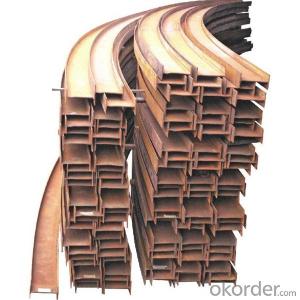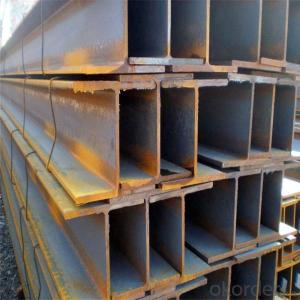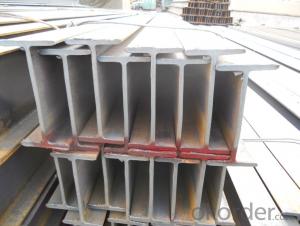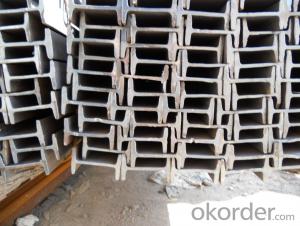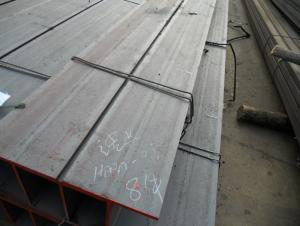Jis Standard H Steel Beams in Stock at Good Price
- Loading Port:
- Dalian
- Payment Terms:
- TT OR LC
- Min Order Qty:
- 100 m.t
- Supply Capability:
- 150000 m.t/month
OKorder Service Pledge
OKorder Financial Service
You Might Also Like
Item specifice
Quick Detail
Standard: | ASTM, GB, JIS | Grade: | Q235Q345ss400ss490 | Dimensions: | HM100*100*6*--8#428*407*20*35 |
Place of Origin: | Hebei, China (Mainland) | Brand Name: | JINXI | Type: | Alloy Structural Steel |
Application: | roof beam | Shape: | Beams | price: | competitive |
We can provide qualify goods,competitive price and speedy delivery.
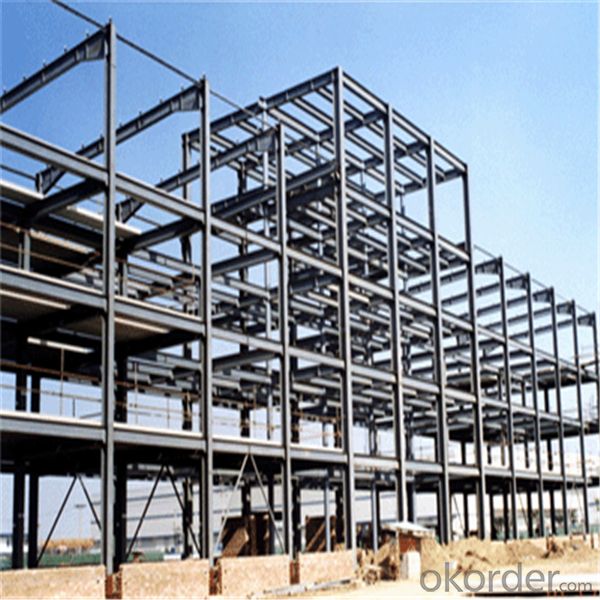
Products Description
H Type Steel Size and Theoretical Weight | |||||
Size | Theoretical Weight | Size | Theoretical Weight | Size | Theoretical Weight |
|
|
|
|
|
|
(mm) | (kg/m) | (mm) | (kg/m) | (mm) | (kg/m) |
100*50*5*7 | 9.3 | 250*125*6*9 | 29 | 446*199*8*12 | 65.1 |
100*100*6*8 | 16.9 | 250*250*9*14 | 71.8 | 450*200*9*14 | 74.9 |
125*60*6*8 | 13.1 | 294*200*8*12 | 55.8 | 482*300*11*15 | 110.8 |
125*125*6.5*9 | 23.6 | 298*149*5.5*8 | 32 | 488*300*11*18 | 124.9 |
148*100*6*9 | 31.1 | 340*250*9*14 | 36.7 | 496*199*9*14 | 77.9 |
150*75*5*7 | 14 | 300*150*6.5*9 | 93 | 500*200*10*16 | 88.1 |
150*150*7*10 | 20.7 | 300*300*10*15 | 78.1 | 582*300*12*17 | 132.8 |
175*90*5*8 | 18 | 346*174*6*9 | 41.2 | 588*300*12*20 | 147 |
175*175*7.5*11 | 40.4 | 350*175*7*11 | 49.4 | 596*199*10*15 | 92.4 |
194*150*6*9 | 29.9 | 350*350*12*19 | 134.9 | 600*200*11*17 | 103.4 |
198*99*4.5*7 | 17.8 | 390*300*10*16 | 104.6 | 700*300*13*24 | 181.8 |
200*100*5.5*8 | 20.9 | 396*199*7*11 | 56.1 | 800*300*14*26 | 206.8 |
200*200*8*12 | 49.9 | 400*200*8*13 | 65.4 | 900*300*16*28 | 240.1 |
244*175*7*11 | 43.6 | 400*400*13*21 | 171.7 |
|
|
248*124*5*8 | 25.1 | 440*300*11*18 | 120.8 |
|
|
Length=6------12meters | |||||
Packaging & Delivery
Packaging Details: | Packed with waterproof paper and steel banding. |
Delivery Detail: | 15-25 |
FAQ
1. How can I get some samples?
We are honored to offer you samples. New clients are expected to pay for the courier cost. The samples are free for you.
2 Do you have any certificates?
Our products passed inspection of SGS, FDA, and CE Quality is priority! Every worker keeps the QC from the very beginning to the very end, Quality control department especially responsible for quality checking in each process.
3 Can your factory print or emboss my logo on the goods?
Yes, we can print or emboss the logo on the goods or their packing box.
4 What information should I let you know if I want to get a quotation?
1) The specification of products (length x width x thickness);
2) The temper and alloy.
3) The final product you will use to be made
4 It will be better if you can show us the pictures or design sketch. Samples will be best for clarifying. If not, we will recommend relevant products with details for reference.We usually produce goods based on customers
Samples or based on customers’ picture, logo, sizes etc.
- Q:How do steel H-beams perform in terms of seismic resistance?
- Steel H-beams are widely acknowledged for their exceptional ability to withstand seismic forces. The distinctive structural design of H-beams, comprising a horizontal web connected to two vertical flanges, offers several advantages in this regard. To begin with, the shape of H-beams allows for more efficient distribution of seismic loads compared to other structural elements. The flanges positioned at the top and bottom of the beam provide enhanced resistance against bending and torsion forces. This design minimizes structural damage and deformation during earthquakes. Additionally, steel H-beams possess high strength and stiffness properties, making them highly suitable for seismic resistance. The use of steel as a construction material provides superior tensile strength, enabling the beams to effectively absorb and dissipate seismic energy. The high strength-to-weight ratio of steel H-beams ensures structural stability and resistance against lateral forces induced by earthquakes. Moreover, steel H-beams exhibit excellent ductility, meaning they can undergo significant deformation without failing. This flexibility and energy absorption capacity help to reduce the overall impact of seismic activity on the structure. The ductility characteristic also allows the H-beams to redistribute forces and stresses, preventing localized damage and promoting overall structural resilience. Furthermore, various techniques can be employed in the design and construction of steel H-beams to enhance their seismic performance. Advanced connection systems, such as moment-resisting connections, can be utilized to ensure the beams maintain their strength and integrity during seismic events. These connection systems facilitate controlled yielding and energy dissipation, further improving the overall seismic resistance of the H-beam structure. In conclusion, the efficient load distribution, high strength, stiffness, and ductility properties of steel H-beams contribute to their excellent seismic resistance. Their ability to withstand seismic forces makes them a popular choice in regions prone to earthquakes, guaranteeing the safety and stability of structures during such events.
- Q:What are the considerations when designing for sustainable materials in Steel H-Beams?
- When designing for sustainable materials in steel H-beams, several considerations need to be taken into account. Firstly, the choice of raw materials is crucial. Opting for recycled or salvaged steel can significantly reduce the environmental impact of the project. Secondly, the manufacturing process should prioritize energy efficiency and minimize waste generation. Implementing advanced technologies, such as electric arc furnaces, can help achieve these goals. Additionally, the design should aim for optimal structural efficiency to minimize the amount of steel required, thus reducing resource consumption. Lastly, considering the end-of-life phase is essential. Designing for easy disassembly and recyclability ensures that the steel H-beams can be reused or repurposed instead of ending up in landfills. Overall, a holistic approach that encompasses the entire life cycle of the material is necessary to achieve sustainability in steel H-beam design.
- Q:Are Steel H-Beams resistant to UV radiation or fading?
- Steel H-Beams are not inherently resistant to UV radiation or fading. However, they can be protected from these effects through the application of a suitable coating or paint that offers UV resistance.
- Q:How do steel H-beams contribute to sustainable building practices?
- Steel H-beams contribute to sustainable building practices in several ways. Firstly, the use of steel as a construction material is highly sustainable due to its durability, recyclability, and long lifespan. H-beams, specifically, are designed to provide structural integrity and support to buildings, allowing for the construction of larger and more sustainable structures. Additionally, the lightweight nature of steel H-beams reduces the overall weight of the building, making it more energy-efficient during transportation and construction. Furthermore, steel H-beams can be prefabricated, reducing on-site waste and construction time. Overall, the use of steel H-beams promotes sustainable building practices by enhancing structural efficiency, reducing waste, and facilitating the use of recyclable materials.
- Q:What are the common inspection methods for steel H-beams?
- The common inspection methods for steel H-beams involve both visual and non-destructive testing techniques. Visual inspection is the initial step in the inspection process, where the surface of the H-beams is examined for any visible defects such as cracks, surface irregularities, or signs of corrosion. Non-destructive testing (NDT) methods are then employed to assess the internal quality of the steel H-beams without causing any damage. These techniques include: 1. Ultrasonic Testing (UT): UT uses high-frequency sound waves to detect internal flaws or defects in the steel H-beams. It is effective in identifying cracks, voids, and inclusions that may compromise the structural integrity of the beams. 2. Magnetic Particle Testing (MT): MT utilizes the principle of magnetic field attraction to identify surface or near-surface defects in the steel H-beams. A magnetic field is applied to the beams, and iron particles are applied on the surface. Any magnetic leakage caused by defects will attract the iron particles, making the defects visible. 3. Dye Penetrant Testing (PT): PT involves the application of a colored liquid dye on the surface of the steel H-beams. The dye penetrates into any surface cracks or defects, and after a specific time, excess dye is removed. A developer is then applied, which draws out the dye from the defects, making them visible for inspection. 4. Radiographic Testing (RT): RT uses X-rays or gamma rays to inspect the internal structure of the steel H-beams. The beams are exposed to radiation, and the resulting image is captured on a film or digital detector. This allows for the detection of internal flaws such as cracks, porosity, or inclusions. These inspection methods are commonly used to ensure the quality and integrity of steel H-beams in various industries, including construction, manufacturing, and infrastructure projects. The combination of visual inspection and NDT techniques provides a comprehensive assessment of the H-beams' condition and helps identify any potential issues before they lead to structural failures.
- Q:How do steel H-beams contribute to energy efficiency?
- There are several ways in which steel H-beams contribute to energy efficiency. Firstly, they are commonly used in the construction industry to provide structural support for buildings and bridges. This helps to minimize excessive energy consumption during the construction process by efficiently distributing loads and reducing the need for additional materials. In addition, steel H-beams are known for their durability and longevity. Unlike materials like wood or concrete, steel beams do not deteriorate over time, resulting in less maintenance and repair work. This leads to reduced energy consumption and costs in the long term. Furthermore, steel is a highly recyclable material. H-beams can be easily melted down and repurposed, reducing the demand for new steel production. This recycling process requires less energy compared to the production of new steel, helping to conserve energy resources and decrease greenhouse gas emissions. Moreover, steel H-beams have excellent thermal properties. They efficiently transfer heat and cold due to their high thermal conductivity. This is particularly advantageous in energy-efficient building designs as it helps regulate temperature and reduces the need for excessive heating or cooling. By minimizing energy consumption for temperature control, steel H-beams contribute to overall energy efficiency in buildings. Overall, steel H-beams contribute to energy efficiency by reducing material waste during construction, providing long-lasting structural support, promoting recycling and reducing greenhouse gas emissions, and optimizing thermal properties for efficient temperature regulation. These qualities make steel H-beams a sustainable and energy-efficient solution for various construction applications.
- Q:What are the design considerations when using steel H-beams in buildings?
- Some key design considerations when using steel H-beams in buildings include the load-bearing capacity of the beams, the structural stability they provide, their resistance to bending and deflection, and their ability to support other building elements such as floors and walls. Additionally, factors such as the required span length, the building's intended use, and any specific architectural or aesthetic requirements must also be taken into account during the design process.
- Q:Do you have H steel 550x300x11x18?
- No, I agree with the opinion of Honghua lang! You're right!
- Q:Can steel H-beams be used in the construction of shopping malls?
- Certainly, shopping malls can utilize steel H-beams for construction purposes. Due to their robustness and endurance, steel H-beams are frequently employed within the construction sector. They deliver crucial support to structures and are commonly employed in the erection of extensive edifices, such as shopping malls. Being capable of enduring substantial weights and offering stability, steel H-beams prove to be an excellent option for constructing the framework of shopping malls. Furthermore, steel is an environmentally friendly and cost-efficient material, making it highly favored in commercial construction ventures.
- Q:Can Steel H-Beams be used in historical or heritage restoration projects?
- Yes, Steel H-Beams can be used in historical or heritage restoration projects depending on the specific requirements and circumstances. While traditional building materials are often preferred for historical restoration, steel H-Beams can offer structural support, durability, and flexibility, particularly when it comes to reinforcing or replacing damaged elements. However, their use must be done carefully and in consultation with experts to ensure compatibility with the existing structure and adherence to preservation guidelines.
1. Manufacturer Overview |
|
|---|---|
| Location | |
| Year Established | |
| Annual Output Value | |
| Main Markets | |
| Company Certifications | |
2. Manufacturer Certificates |
|
|---|---|
| a) Certification Name | |
| Range | |
| Reference | |
| Validity Period | |
3. Manufacturer Capability |
|
|---|---|
| a)Trade Capacity | |
| Nearest Port | |
| Export Percentage | |
| No.of Employees in Trade Department | |
| Language Spoken: | |
| b)Factory Information | |
| Factory Size: | |
| No. of Production Lines | |
| Contract Manufacturing | |
| Product Price Range | |
Send your message to us
Jis Standard H Steel Beams in Stock at Good Price
- Loading Port:
- Dalian
- Payment Terms:
- TT OR LC
- Min Order Qty:
- 100 m.t
- Supply Capability:
- 150000 m.t/month
OKorder Service Pledge
OKorder Financial Service
Similar products
New products
Hot products
Hot Searches
Related keywords

